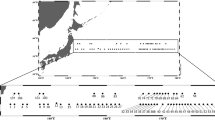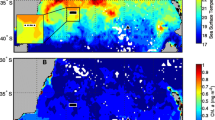Abstract
In order to estimate the in situ grazing rates of Salpa thompsoni and their implications for the development of phytoplankton blooms and for the sequestration of biogenic carbon in the high Antarctic, a repeat-grid survey and drogue study were carried out in the Lazarev Sea during austral summer of 1994/1995 (December/January). Exceptionally high grazing rates were measured for S. thompsoni at the onset of a phytoplankton bloom (0.2 to 0.8 μg chlorophyll a l−1) in December 1994, with up to ≃160 μg of plant pigments consumed by an individual salp of 7 to 10 cm length per day. Dense salp swarms extended throughout the marginal ice zone, consuming up to 108% of daily phytoplankton production and 21% of the total chlorophyll a stock. Due to the much faster sinking rates and higher carbon content of salp faecal pellets, the efficiency of downward carbon flux through salps is much higher than through the other major grazers, krill and copepods. S. thompsoni can thus export large amounts of biogenic carbon from the euphotic zone to the deep ocean. With the observed ingestion rates during December 1994, this flux could have attained levels of up to 88 mg C m−2 d−1, accounting for the bulk of the vertical transport of carbon in the Lazarev Sea. However, in January 1995, when phytoplankton concentrations exceeded a threshold level of 1.0 to 1.5 μg chlorophyll a l−1, salps experienced a drastic reduction in their feeding efficiency, possibly as a result of clogging of their filtering apparatus. This triggered a dramatic reversal in the relationship, during which a dense phytoplankton bloom developed in conjunction with the collapse of the salp population. Increases in the biomass and geographic range of the tunicate S. thompsoni have occurred in several areas of the southern ocean, often in parallel with a rise in sea-surface temperature during sub-decadal periods of warming anomalies.
Similar content being viewed by others
Author information
Authors and Affiliations
Additional information
Received: 10 August 1997 / Accepted: 21 October 1997
Rights and permissions
About this article
Cite this article
Perissinotto, R., Pakhomov, E. Contribution of salps to carbon flux of marginal ice zone of the Lazarev Sea, southern ocean. Marine Biology 131, 25–32 (1998). https://doi.org/10.1007/s002270050292
Issue Date:
DOI: https://doi.org/10.1007/s002270050292




